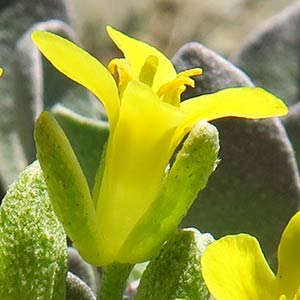|
alpine twin-pod, Washington bladder-pod, Washington twin-pod
|
White Mountain bladderpod
|
| Perennials; caudex usually simple, rarely branched, (cespitose); (silvery) pubescent throughout, trichomes several-rayed, rays (1- or) 2-bifurcate, (low-umbonate, tubercles relatively few, small). |
Perennials; caudex simple or branched; densely pubescent, trichomes (sessile or short-stalked), 6–8-rayed, rays furcate or bifurcate, (tuberculate, less so on outer layers). |
several from base, decumbent to ascending, (unbranched), 0.5–1.5 dm. |
simple or few from base, ascending to erect, (0.5–)1–2(–3.5) dm. |
(petiole slender); blade obovate, 3–5 cm (width 10–20 mm, base tapering abruptly to petiole), margins entire, (apex rarely slightly acute). |
(petiole tapering to blade); blade rhombic to elliptic and irregularly angular, sometimes spatulate to oblanceolate, 1.5–7.5(–10) cm, margins entire. |
blade oblanceolate, 0.5–1.5 cm (width 3–5 mm), margins entire. |
(not or loosely overlapping, petiolate or distal sessile); blade spatulate to oblanceolate, 1–4 cm, margins entire. |
subcorymbose. |
crowded, elongated. |
sepals oblong, 8–10 mm; petals spatulate, 12–14 mm. |
sepals ovate, oblong, or elliptic 4–7.5 mm, (median pair thickened apically, cucullate); petals spatulate or broadly cuneate, 6–13 mm, (claw slightly expanded at base). |
(divaricate, straight), 5–10 mm. |
(ascending, curved or sigmoid), 6–12(–20) mm. |
didymous, mostly highly inflated (strongly flattened at least in 1/2 toward replum), 14–18 × 14–18 mm, (papery, basal sinus slightly notched, apical open, shallow); valves (retaining seeds after dehiscence), evenly pubescent; replum lanceolate, 7–10 mm, width 1.5–2.5 mm, as wide as or wider than fruit, apex acute to acuminate; ovules 8–10 per ovary; style 5–7 mm. |
(substipitate), globose or obovoid to ellipsoid, sometimes slightly obcompressed, 4–9 mm; valves (not retaining seeds after dehiscence), glabrous throughout; replum as wide as or wider than fruit; ovules 4–24 per ovary; style (2–)4–7 mm. |
flattened, (2–3 mm). |
flattened. |
= 48–52, 52, 64, 67–70. |
= 10. |
|
|
|
|
| Flowering May–Jun. |
Flowering Apr–Jul. |
| Alpine scree, rocky ridges, talus slopes, volcanic sands and gravel, serpentine gravel, granitic slopes, mountain shrub, subalpine fir, and whitebark pine communities |
Scrub oak, pinyon-juniper woodland, open ponderosa pine forests, these sometimes mixed with Douglas fir, white pine, white fir, Engelmann spruce, or Gambel oak, on limestone-derived or otherwise basic soils, often in rock crevices |
| (700-)1300-2400 m ((2300-)4300-7900 ft) |
1400-2900 (-3400) m (4600-9500 (-11200) ft) |
|
WA
|
AZ; NM
|
|
Physaria pinetorum with reduced forms are found at high elevations; in disturbed, moist soils plants can become quite large, as in the Manzano Mountains. Densely cespitose plants with crowded racemes not exceeding the basal leaves are found at the crest (3200–3400 m) of the Sandia Mountains, New Mexico. These probably represent an undescribed taxon. (Discussion copyrighted by Flora of North America; reprinted with permission.) |
| FNA vol. 7, p. 624. |
FNA vol. 7, p. 658. |
| Brassicaceae > tribe Physarieae > Physaria |
Brassicaceae > tribe Physarieae > Physaria |
P. acutifolia, P. alpina, P. angustifolia, P. arctica, P. arenosa, P. argyraea, P. arizonica, P. aurea, P. bellii, P. brassicoides, P. calcicola, P. calderi, P. carinata, P. chambersii, P. cinerea, P. condensata, P. congesta, P. cordiformis, P. curvipes, P. densiflora, P. didymocarpa, P. dornii, P. douglasii, P. eburniflora, P. engelmannii, P. eriocarpa, P. fendleri, P. filiformis, P. floribunda, P. fremontii, P. garrettii, P. geyeri, P. globosa, P. gooddingii, P. gordonii, P. gracilis, P. grahamii, P. hemiphysaria, P. hitchcockii, P. humilis, P. integrifolia, P. intermedia, P. kingii, P. klausii, P. lata, P. lepidota, P. lesicii, P. lindheimeri, P. ludoviciana, P. macrocarpa, P. mcvaughiana, P. montana, P. multiceps, P. navajoensis, P. nelsonii, P. newberryi, P. obcordata, P. obdeltata, P. occidentalis, P. oregona, P. ovalifolia, P. pachyphylla, P. pallida, P. parviflora, P. parvula, P. pendula, P. pinetorum, P. prostrata, P. pruinosa, P. pulvinata, P. purpurea, P. pycnantha, P. rectipes, P. recurvata, P. reediana, P. rollinsii, P. saximontana, P. scrotiformis, P. sessilis, P. spatulata, P. subumbellata, P. tenella, P. thamnophila, P. tumulosa, P. valida, P. vicina, P. vitulifera |
P. acutifolia, P. alpestris, P. alpina, P. angustifolia, P. arctica, P. arenosa, P. argyraea, P. arizonica, P. aurea, P. bellii, P. brassicoides, P. calcicola, P. calderi, P. carinata, P. chambersii, P. cinerea, P. condensata, P. congesta, P. cordiformis, P. curvipes, P. densiflora, P. didymocarpa, P. dornii, P. douglasii, P. eburniflora, P. engelmannii, P. eriocarpa, P. fendleri, P. filiformis, P. floribunda, P. fremontii, P. garrettii, P. geyeri, P. globosa, P. gooddingii, P. gordonii, P. gracilis, P. grahamii, P. hemiphysaria, P. hitchcockii, P. humilis, P. integrifolia, P. intermedia, P. kingii, P. klausii, P. lata, P. lepidota, P. lesicii, P. lindheimeri, P. ludoviciana, P. macrocarpa, P. mcvaughiana, P. montana, P. multiceps, P. navajoensis, P. nelsonii, P. newberryi, P. obcordata, P. obdeltata, P. occidentalis, P. oregona, P. ovalifolia, P. pachyphylla, P. pallida, P. parviflora, P. parvula, P. pendula, P. prostrata, P. pruinosa, P. pulvinata, P. purpurea, P. pycnantha, P. rectipes, P. recurvata, P. reediana, P. rollinsii, P. saximontana, P. scrotiformis, P. sessilis, P. spatulata, P. subumbellata, P. tenella, P. thamnophila, P. tumulosa, P. valida, P. vicina, P. vitulifera |
| Lesquerella alpestris |
Lesquerella pinetorum |
| Suksdorf: W. Amer. Sci. 15: 58. (1906) |
(Wooton & Standley) O’Kane & Al-Shehbaz: Novon 12: 327. (2002) |
| |


